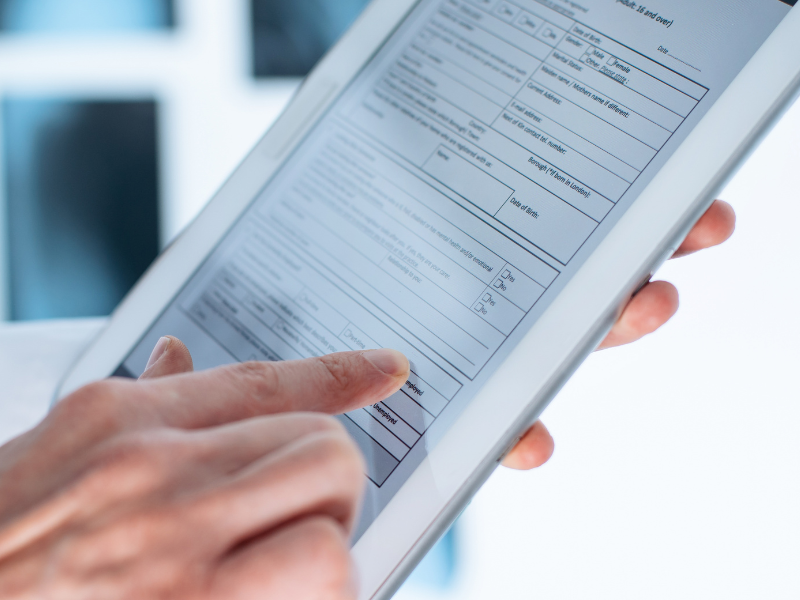Medical records contain confidential information about a person’s diagnosis, medications, and treatment plans. Without providing consent to healthcare providers, these data may be compromised and given to the wrong hands.
By understanding the purpose and importance of HIPAA authorization forms, patients and healthcare professionals can navigate the complex landscape of health information privacy and ensure compliance with relevant regulations.
Table of Contents

What Is A HIPAA Authorization Form?
A HIPAA authorization form is a legal document granting healthcare providers and other authorized entities permission to use or disclose a patient’s protected health information (PHI) for specific purposes.
These forms outline the types of information to be disclosed, including:
- the parties involved
- the purpose of the disclosure, and
- the duration of the authorization
Purpose and Importance of HIPAA Authorization Forms
HIPAA authorization forms serve multiple purposes and hold significant importance in healthcare.
Patient privacy protection
Requiring explicit consent for using and disclosing your patient’s PHI is vital to establish your organization’s credibility. A HIPAA authorization form allows patients to decide who can access their health information.
Facilitating treatment and coordination of care
Authorization forms allow healthcare providers to share patient information with other authorized parties, particularly those directly involved in their treatment or care coordination. This helps ensure seamless communication and collaboration among different healthcare entities. Ultimately, it also enables you to deliver an enhanced quality of care.
Research and study participation
With proper patient consent through HIPAA authorization forms, healthcare organizations can use PHI for medical research, clinical trials, and other studies. This supports advancements in healthcare and the development of new treatments and therapies.
Legal compliance
Healthcare providers and organizations must comply with the Health Insurance Portability and Accountability Act (HIPAA) regulations regarding the patient’s privacy and security. By obtaining written authorization, they demonstrate their commitment to maintaining the integrity of sensitive health information.
6 Components of a HIPAA Authorization Form
By understanding these six key components, healthcare professionals can ensure compliance with HIPAA regulations while still providing necessary care to their patients.
1. Patient information
The HIPAA authorization form begins with a section that collects the patient’s name, date of birth, contact details, and other relevant identifiers. Accurate patient information ensures that the authorization form applies to the correct individual with their privacy preferences.
2. Outline of the information to be disclosed
In this section, the form specifies what kind of protected health information (PHI) the patient authorizes to disclose. It may include medical records, test results, and treatment plans.
3. Recipient of the information
The HIPAA authorization form identifies who will receive the medical records. This could be another healthcare provider, insurance company, family member, or other legal representative involved in the patient’s care.
4. Purpose of the disclosure
Clearly stating the purpose helps patients make informed decisions about their health information. It could be for treatment purposes, healthcare operations, or research. The disclosure must also align with their intentions and preferences.
5. Duration of authorization
This section determines the duration for which the HIPAA authorization remains valid. Defining the length or period is vital for ensuring that the form remains valid only throughout the specified time frame. Doing so promotes control and, at the same time, limits the risks of unnecessary disclosure.
6. Revocation rights
HIPAA authorization forms highlight the patient’s right to revoke the authorization at any given moment. Through this, patients can immediately change their PHI preferences and stop any disclosure attempt that goes against their best interest.
3 Essential Elements of a HIPAA Authorization Form
By incorporating these elements, healthcare organizations and their patients can navigate the process of authorizing the release of health information with confidence and compliance.
1. Clear and specific language
A well-crafted HIPAA authorization form uses clear and specific language to ensure that patients fully understand what it says. It avoids ambiguous terms and provides clear explanations to minimize confusion and prevent misinterpretation.
2. HIPAA Privacy Notice
With a Privacy Notice, healthcare organizations can specify how patient health information is used, disclosed, and protected. Patients have access to their privacy rights to help them know the importance of giving consent to appropriate parties.
3. Patient signature and date
A signature signifies that the patient has read and understood the form, agrees to the terms, and gives informed consent to disclose their protected health information. Meanwhile, the date on the signature line proves the signature’s validity.

How to Fill Out HIPAA Authorization Forms Correctly
When filling out authorization forms, it is crucial to ensure the accuracy of PHI. The first step is to identify and avoid these common mistakes, so it will be easier to complete the form correctly.
Incomplete or missing information
Ensure to accurately fill out all the required fields, including the patient’s full name, contact information, and other details. Failing to provide complete information can lead to delays or errors in processing, potentially impacting the timely sharing of vital health documents.
Vague descriptions
When authorizing the release of protected health information (PHI), avoid putting in vague descriptions that may result in the unintended disclosure of sensitive health information. Take time to fill out forms and always double-check for errors and mistyped information.
Incorrect recipient information
Verify the recipient’s details, such as the name, address, or email. Incorrect recipient information may lead to unauthorized access or confidentiality breaches. Remember to double-check the recipient information to safeguard your patient’s privacy.
Failure to specify purpose or duration
Whether it’s for treatment or research, It’s essential to state the purpose of the PHI disclosure clearly. Specifying the duration of the authorization ensures that the disclosure is only valid for a specific period.
The Role of HIPAA Authorization in Patient Privacy
By granting permission to release protected health information (PHI), patients maintain control over who can access their sensitive medical data. It also lets them choose and indicate who will receive their confidential information.
Healthcare organizations, on the other hand, can foster a culture of privacy, trust, and respect for patient confidentiality. At the same time, it lets them comply with the regulations set by HIPAA.
Tips for Ensuring a Correctly Completed HIPAA Authorization Form

Review the form instructions
Take the time to carefully review the instructions stated on the form, including any specific formatting or documentation requirements. This will help you avoid any mistakes when filling out the form.
Provide complete and accurate information
Make sure that all required fields are filled out, including the patient’s full name, contact information, and any specific details requested. Inaccurate or incomplete information can lead to processing errors and delays. Double-check all the facts before submitting the form to ensure accuracy.
Specify the necessary information
Be clear and specific when describing the type of protected health information (PHI) that you are authorizing for release. Concise descriptions help ensure that the authorized parties understand the scope of the disclosure.
Verify recipient details
Check the accuracy of the recipient’s information before submitting the authorization form. Make sure that the name, organization, address, or contact details are correct. Providing incorrect recipient information can lead to unauthorized access.
Maintaining Patient Privacy Using HIPAA Authorization Forms
The HIPAA authorization form is critical for protecting patient confidentiality and ensuring compliance. It is essential for maintaining transparency and patient privacy in the healthcare environment. More importantly, it gives patients control over how they want their PHI to be disclosed.







